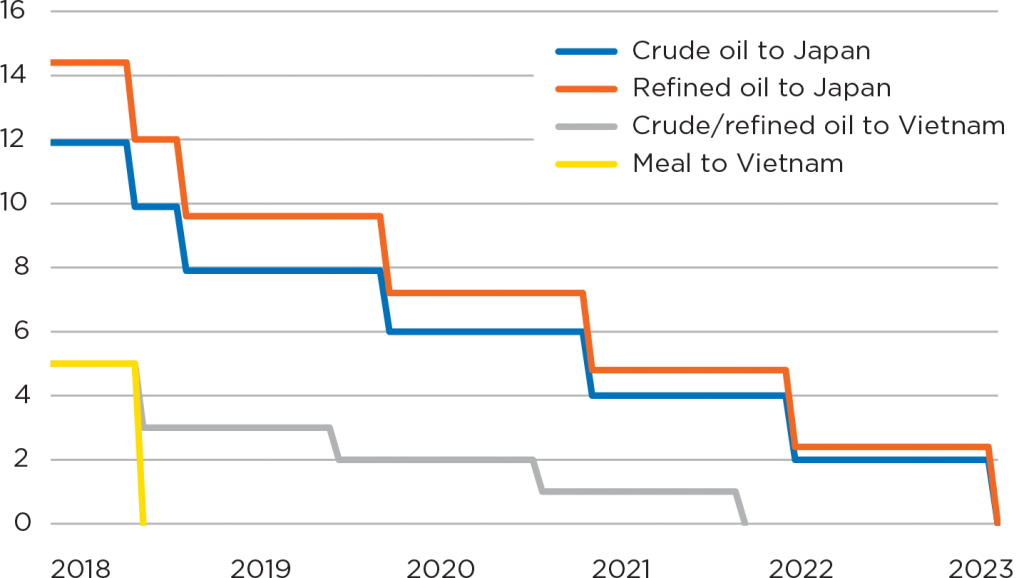Three new trade agreements bring value beyond volume
The past 18 months have been momentous for Canadian canola exporters. Since September 2017, three major trade agreements have either come into force or moved toward ratification, giving Canada preferential access to markets making up two-thirds of the world economy.
Shrinking tariffs means more Canadian canola will be bound for export markets and more value will make it back to Canada. But the goal of these trade agreements is more strategic. The ultimate aim is to get the most for our canola in export markets so that the benefits can ripple through the value chain and throughout the Canadian economy.
“At the end of the day, these trade agreements are not about the big corporations getting a two per cent or five per cent reduction in tariffs. They’re about bringing more money into the local economy,” says Kevin Serfas, a Canola Council of Canada board member who farms near Turin, Alta. “It starts with the exporters, moves down to the farmers and carries through to the farm machinery dealerships and other local businesses.”
| Agreement | What it means for canola | Status | Expected impact |
|---|---|---|---|
| CETA Canada-European Union Comprehensive Economic and Trade Agreement | Elimination of all tariffs on canola oil and biodiesel entering the 28 member-states of the EU. | Implemented in September 2017. Ratification continues in individual member states. | Increased exports valued at up to $90 million annually. |
| CPTPP Comprehensive and Progressive agreement for Trans-Pacific Partnership | Gradual reductions in tariffs on imports of canola oil and meal, with complete elimination by 2023. | Ratified by seven countries (Canada, Mexico, Japan, Singapore, New Zealand, Australia and Vietnam), with Chile, Peru, Brunei and Malaysia countries expected to come on board in 2019.Tariff reductions started December 30, 2018. | Up to $780 million increase in annual exports of canola oil and meal. |
| CUSMA Canada-United States-Mexico Agreement | Canola seed, oil and meal remain free of tariffs.Tariffs will be removed on further- processed products like margarine.Dispute settlement mechanisms. strengthened through new chapters on competitiveness and good regulatory practices. | Signed in November 2018. Awaiting ratification in Canada, | Continued stability in a $3.7 billion market for Canadian canola oil, meal and seed. |
More opportunity for value-added products
One of the most exciting aspects of the Comprehensive and Progressive Agreement for Trans-Pacific Partnership (CPTPP) is the elimination of tariffs on Canadian canola oil exports to Japan. That’s a huge boon to Canadian oilseed processors. High tariffs will gradually decline to zero by 2023, putting Canada on equal footing with our Australia competitors, who have enjoyed a free trade agreement with Japan for several years. Japanese customers will then be able to choose whether they import canola seed, canola oil or canola meal.
Japan is not a new market for Canadian canola. In fact, Japan is our most consistent importer, and canola oil has become the number one edible oil in the country. But until now, Japan has imported only canola seed, which is then processed at its own plants. That means the value-added benefits of our strong trade relations with Japan were limited – until CPTPP was implemented at the end of 2018.
“Once the tariffs on value-added products are phased out, we expect canola oil and meal exports to grow by up to $780 million,” says Brian Innes, the Canola Council’s vice president of public affairs. “We’ve been chasing this market for years and it’s really amazing that it’s finally going to happen.”
The CPTPP is opening up similar opportunities for value-added products in the promising market of Vietnam. That country’s tariff on Canadian meal imports completely disappeared on January 14, 2018, and the country’s tariff on oil will gradually drop to zero by 2022.
Meanwhile, the Canada-European Union Comprehensive Economic and Trade Agreement (CETA) has opened up more opportunities for value-added products by eliminating all tariffs on Canadian canola oil and biodiesel entering the world’s largest market for biofuels.
More processing jobs to stimulate local economies
With the certainty of tariff-free access for value-added products in nearly 40 countries, Canadian companies are gearing up to expand domestic processing. One company looking forward to the new opportunities is Cargill, which has steadily grown its Canadian processing capacity over the past few years – most notably at Camrose, Alta., where a new state-of-the-art plant opened in 2015.
Ken Stone, assistant vice president for Cargill’s Canadian canola processing business, says the new trade agreements will allow the industry to go toe-to-toe against the big vegetable oil commodities like sunflower, palm and soy. “Then we’ll really be in a position to leverage the economies of scale we have at places like Camrose, while bringing a great product to these markets,” he said.
As processing expands here in Canada, new jobs will soon follow. In Camrose, for example, the Cargill plant has created 75 new jobs.
Preserving an integrated supply chain with our biggest market
For Kevin Serfas, the most impactful of the three new trade accords is the Canada-United States-Mexico Agreement (CUSMA), which is aimed at maintaining tariff-free access to two of Canadian canola’s largest markets.
“Some see [CUSMA] as just a rejigging of NAFTA, but keeping
that trade relationship in place is the most important part
of the puzzle. To lose it would be disastrous.”
“Some see it as just a rejigging of NAFTA, but keeping that trade relationship in place is the most important part of the puzzle,” says the Alberta farmer. “To lose it would be disastrous.”
The many companies involved in agri-food processing on both sides of our border would agree, and for a variety of reasons. Under NAFTA, these companies have formed regional supply chains that rely on the free flow of products back and forth across borders as they undergo further processing.
For example, a U.S. food manufacturer might import canola oil as an ingredient for its salad dressing or frozen lasagna, which it then ships back to Canada for sale through retailers and restaurants. The absence of tariffs means businesses can keep operating costs low as products move through these cross-border supply chains, which ultimately results in lower prices to the consumer and a globally competitive North American agri-food industry. The CUSMA will preserve this advantage, boding well for the future of North America’s food manufacturing sector.
“There were also some additional wins for supply chains under the CUSMA,” Innes says. “The rules of origin were updated for further-processed products, which means that canola-based margarine will be tariff-free as it enters the U.S. market.”
Table 4

What’s next
The Canola Council and industry partners spent countless hours working with Canadian negotiators as the CPTPP, CETA and CUSMA took shape. Now that the agreements are signed, the next goal is to make progress on the non-tariff barriers that can interfere with market access in a highly regulated realm like agri-food. Alignment of food and feed safety regulations, maximum residue limits related to pesticides and plant breeding innovations are among the many potential issues that can be resolved through the working groups committed to by members
of the CPTPP and CETA.
“Through NAFTA, we’ve seen how effective this approach can be,” Innes said. “The working group on pesticides was the most successful of the NAFTA working groups, and we now have the opportunity to continue this good work with a much larger group of trading partners.”





